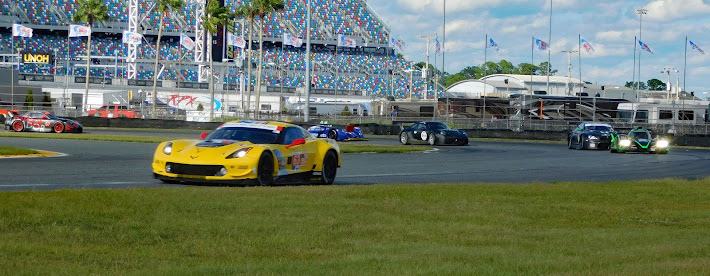Daytona, October 30, 2021 This blog has focused on classic cars and on fast cars. This blog post will be the first of a series focusing on classic cars that are fast and continue to prove that by racing in competition. The above photo has a Corvette C7.R leading a group of cars out of the International Horseshoe corner at Daytona International Speedway.
HSR is a sanctioning body for vintage racing, although the cars that race in their series are not very vintage. They avoid the vintage name in their title - Historic Sportscar Racing - with historic having a broad definition when it comes to the age of the cars racing.
However, as with all vintage racing, the atmosphere is relaxed with the spectators having access to all areas of the racetrack and the pits. In the pits, the drivers and mechanics take time to share information and stories.
The pits are like a museum of historic race cars. This car is a Porsche 935, one of the most successful race cars of all time. The 935 won races all around the world and dominated the GT classes for years. A 935 even earned and overall win at the Rolex 24 Hours of Daytona beating the prototypes one year.
In the prototype class, the Porsche 962 was dominant from the 24 Hours at Daytona to the 24 Hours de LeMans. There were multiple 962 at the Classic 24 Hours. They are beautiful cars that are fast and reliable. They are also rare and desirable, which has moved their sales prices above $1 million. Million dollar cars out on the race track.
And, those in attendance not only get to see the cars up close and personal, they also get to examine all the engineering and technology as the crews work on the cars. This is another of the 962s at the Classic 24 Hours.
Another piece of racing history, a 1982 Jaguar XJR, This car one many sportscar races and was the leading technology of its time. Again, successful from the Daytona 24 Hours to LeMans. This example is one prepared and raced by the Bob Tulius organization, Group 44, thus the chosen race number on this car. Another car in the race must have registered earlier wit the 44 number, so the Jaguar team added a 1 before the number.

It takes a lot of tubing to make exhaust headers for a V-12 engine. Today's sportscar prototypes are very similar in design due to restrictive rules designed to keep competition close. Racing began, and continued for decades to be an experiment in how to make cars better - more powerful, better handling, more reliable - with many variations in design. Jaguar chose to compete with a naturally-aspirated V-12. Porsche chose a twin-turbocharged flat-six engine. Again, vintage racing allows one to closely examine the engineering, design, and construction of race cars.
A much newer version of the prototype race car, a Cadillac built to the newer Daytona Prototype standards. It was originally built and raced by the Wayne Taylor race team located in Orlando, Florida. This Cadillac enjoyed much success with numerous race wins and a couple of season championships. Historic, yes. Vintage, no.
Another car with a very recent racing history, the Corvette C7.R, which raced with much success in the GT class though the 2020 season. This is one of the first C7.Rs, a 2014 model. There were two of the C7.Rs entered. On the track, at this race, they were faster than many of the prototypes. The machine hooked up to the engine was an engine warmer, running hot water through the engine so that it was warm on start-up.

This 2012 Cayotte Corvette represents an earlier Daytona Prototype formula. This car design, which had support from General Motors in development, was succeeded by the Cadillac. It was difficult to get a clear photo of the car because of the girls in outfits matching the car always standing in the way.
A 1969 Lola leads a couple of older Corvettes and a gaggle of Porsches. Finally, a car that meets many racing organizations definition of a vintage race car - 1972 or before. These cars all look at home at Daytona because they all raced there in their period.
A Lamborghini leads another gaggle of Porches with a yellow Ferrari thrown in the mix. There are many vintage racing sanctioning bodies organizing races across the county - HSR, SVRA, VSCCA, VDCA, VRG, VSCDA, and more. Vintage Racing has become more popular, giving amateur racers a chance to experience racing on some of the greatest race tracks in the world.
A shot of only Porsches, the ever-popular race car of the 911 chassis. The design of the car evolved over decades, although the basic body design was always similar and recognizable. There were many race cars built, and they were reliable, a formula for having many still racing today.
Vintage Racing - a new and popular segment of the motorsports and classic car hobbies.
Find a race near you to experience yourself.



























































